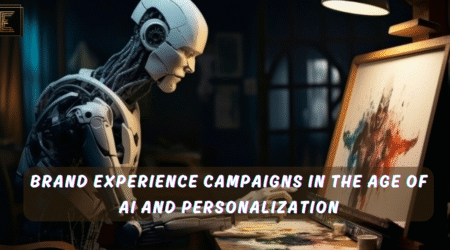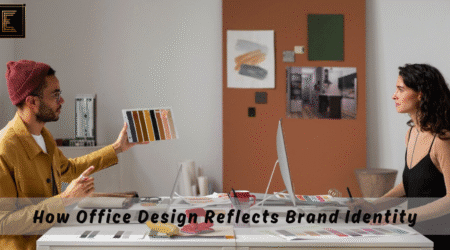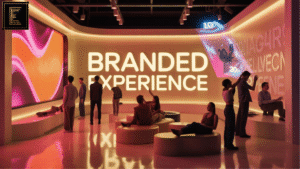In a world full of choices, what truly sets a brand apart isn’t just its logo or tagline—it’s the experience it creates.
Whether you walk into a stylish boutique, a cozy café, or a high-end salon, the way the space feels instantly tells you something about the brand. That’s the power of Brand Experience Management—and it’s becoming one of the most important tools for building emotional connections with customers.
But here’s where it gets interesting: the design of your physical space plays a huge role in that experience. The lighting, layout, colors, textures, and even the scent of a space can influence how customers feel, behave, and remember your brand.
In this blog, we’ll explore how space design impacts brand experience management, why smart, intentional environments matter, and how you can transform ordinary places into powerful brand storytellers. If you want to boost loyalty, create memorable impressions, and stand out in a competitive market, this is where it starts.
What is Brand Experience Management?
Brand Experience Management (BXM) is the process of designing and managing every interaction a customer has with your brand—especially the emotional and sensory ones.
It focuses on:
- Creating consistent and impactful brand touchpoints
- Engaging customers through storytelling and emotion
- Building long-term loyalty by offering more than just products
Whether online or offline, every brand interaction is part of the experience. But your physical space is often the most impactful and immediate way to leave a lasting impression.
How Space Design Impacts Brand Experience Management
Your environment speaks louder than words. The layout, lighting, scent, music, and even seating arrangement influence how people feel and behave.
Here’s how space design affects brand experience:
- First impressions: A clean, welcoming space builds trust instantly
- Customer flow: A smooth layout guides customers intuitively
- Emotional response: Colors, textures, and lighting set the tone
- Engagement levels: Interactive or cozy areas encourage longer stays
Example:
Apple Stores use minimalistic design to reflect innovation and simplicity.
Starbucks develops comfortable spaces where people may work, meet, or stay.
The Importance of Smart Design in Brand Experience Management
Smart design means more than just aesthetics—it means intentional design that supports brand goals and customer needs.
Why smart design matters:
- Reflects brand identity through color, texture, and layout
- Improves functionality with easy navigation and adaptive spaces
- Enhances accessibility and inclusivity for all users
- Drives conversions with well-placed displays and call-to-actions
Here’s a quick comparison:
| Element | Poor Design | Smart Design |
| Layout | Cluttered, confusing | Clear, intuitive flow |
| Lighting | Harsh or dim | Mood-appropriate and brand-aligned |
| Branding | Generic setup | Reflective of brand story and emotion |
| User Engagement | Passive browsing | Interactive and experiential zones |
| Comfort | Unwelcoming environment | Warm, inviting spaces |
Smart design = more trust + better experience + stronger brand.
Brand Experience Management Through Experiential Space Design
Experiential space design is about creating environments that customers remember—not because they shopped there, but because they felt something there.
What makes a space “experiential”?
- Multisensory design: Combining visuals, scent, sound, and touch
- Interactive features: Digital kiosks, AR/VR, product demos
- Brand storytelling: Displays that tell your journey or values
- Emotional connection: Creating moments that spark joy or nostalgia
This approach is key to brand experience management through experiential space design, where your store or office becomes a stage for your brand’s story.
5 Creative Ways to Improve Brand Experience Management with Creative Spaces
Looking to upgrade your space? Try these simple but powerful ideas:
- Integrate AR/VR Technology
Let customers explore your products virtually, boosting interaction. - Create Instagrammable Corners
Set up photo-worthy spots that reflect your brand—hello, free social promotion! - Modular Layouts
Use flexible furniture or displays that can change based on season or promotion. - Sensory Branding
Choose a signature scent or playlist to emotionally connect with visitors. - Go Green with Sustainable Materials
Show your values through recycled materials, indoor plants, and eco-lighting.
These techniques are proven ways to improve brand experience management with creative spaces, helping you stand out in a crowded market.
The Role of Physical Space Design in Brand Experience Management Success
Want your brand to stand out, get remembered, and win loyalty? Focus on your physical space. It is essential to the success of brand experience management.
Here’s why:
- Enhances brand perception: Premium, trendy, eco-conscious—your space says it all.
- Supports customer behavior: Easy-to-navigate spaces improve satisfaction and conversions.
- Encourages word-of-mouth: People love sharing unique, well-designed spaces on social media.
- Boosts employee morale: A great space improves both customer and team experience.
Whether you’re a salon, café, retail store, or gym, your space can become a competitive advantage if you design it with intention.
Conclusion
In the experience economy, your brand is not just what you sell—it’s how people feel when they interact with you. That feeling is heavily influenced by your physical environment.
From the walls to the scent to the music playing in the background, every detail matters. Smart space design isn’t a luxury—it’s a must-have if you want to create strong emotional connections with your audience.
By understanding the importance of smart design in brand experience management, embracing experiential elements, and applying creative strategies, you can turn every visit into a story worth remembering—and sharing.
Now ask yourself: is your space telling the right story?
FAQs
1. What is Brand Experience Management?
Brand Experience Management is the process of shaping customer perceptions and emotions through strategic brand interactions—especially through physical and sensory experiences.
2. How does space design influence brand perception?
From layout to lighting, the design of a space can create emotional responses, improve engagement, and align with your brand identity, significantly impacting how your brand is perceived.
3. Why is experiential space design important?
Experiential design creates immersive, interactive environments that make customers feel emotionally connected, leading to better recall and stronger loyalty.
4. What are budget-friendly ways to improve space design?
You can use elements like wall art, lighting, indoor plants, custom signage, and rearranged layouts to enhance space design affordably.
5. How can space design lead to brand experience management success?
Well-designed spaces improve customer flow, create emotional connections, support branding, and increase satisfaction—all of which contribute to overall brand success.







